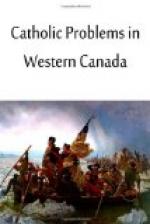The West, we know too well, has many things yet to learn from the East; but good old Mother East should at times forget “what has been”—and consider more “what is to be.” In many points her growing western daughters can give her helpful suggestions. Moreover this exchange of ideas in an immense Dominion like ours is, we claim, absolutely necessary to keep the mental equilibrium between East and West. There are let us not forget it, many other problems beside the tariff problem which are widening the breach, deepening the chasm between these two sections of our Country. True patriotism demands co-operation, and not antagonism, between these two main sectors of that immense firing line, which is flung between the Atlantic and the Pacific.
1. History.—The history of the “Better School Movement” in Saskatchewan is not very old, but, like the vegetation on the western prairies had a rapid and healthy growth. It crowded into a few years a whole epoch of the educational life of the Province. On June 22, 1915, the Hon. W. Scott, then Premier and Minister of Education, made his epochal speech which launched the idea of a reform movement. The object of this movement was the re-adjustment of the school system, of its curriculum and administration, to conditions existing throughout the Province. The people of Saskatchewan were invited to constitute themselves a grand committee of the whole on education, to study facts and to suggest means. This invitation of the keen-sighted Premier was accepted by the people without any distinction of race, creed or language. The leader of the Opposition indorsed the idea and pledged the support of his party. This non-partisan movement crystallized itself in the “Saskatchewan Public Education League” which was formed at the general meeting of delegates from all over the Province, held in Regina, in Sept., 1916. The league became a forum for the expression of public opinion. The newspapers of the Province gave wide publicity to the new movement and threw open their columns to a public discussion. Teachers’ associations, inspectors’ conventions, church synods, grain growers’ meetings, labour unions, medical councils, trustees’ conventions particularly, made school improvements a fruitful topic at all their meetings of the year. Educational problems and reforms were in the air: never have we better understood the educational value of a publicity campaign; never have we seen it crowned with such a success. The climax of this campaign was a public holiday, June 30th, 1916; meetings were held in all the school districts of the Province, speeches were made, resolutions passed. Public opinion had been moulded and was ready for a “Survey” and Legislation.
By order in Council, June 7th, 1917, Premier Martin, successor to Hon. W. Scott, whom ill-health had forced to retire—made definite provision for an educational Survey. “This survey is in no sense of the word an investigation; for investigations are necessarily based on assumption of some sort of misfeasance or malfeasance. It is instead a sympathetic inquiry into the schools of the people as the schools actually exist. Suggestions for enlargement and re-direction are made throughout.”




